Depending on who you are, eBay is either the best thing since sliced bread, or it’s the Devil…for many camera collectors it can be a bit of both.
eBay has been around since 1995 and since then has become the defining source for online bargain shopping. You can buy everything from cars to planes to antiques to entire towns to new species of animals to…pretty much everything. The site is available to shoppers in almost every country on the planet, and has a net worth of several billions of dollars.
Like any large company, it has it’s ups and downs, and for those of you like me who collect old cameras, there will undoubtedly be aspects that you love and some that you hate.
Despite your opinions of eBay, it is an invaluable resource for collectors of old cameras. If there is a model you are looking for, there is a very good chance one will be for sale at any given time, and even if it is not, just wait a little while, and one will probably show up.
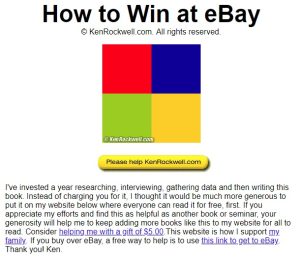
Many people have written guides on how to get good deals on eBay or how to “win” at eBay, and while these guides aren’t bad, they all promise unrealistic results as there really is no way to win at eBay. Ken Rockwell can claim to have won 97% of the auctions he bids on, and I guess that might be statistically possible, but it’s certainly not a realistic goal for most people out there. I guess in theory, you could find 100 auctions, and use the Buy it Now option on 97 of them and say you “won” 97% of the time, but that’s kinda fudging the numbers.
I have purchased a large number of cameras on eBay and while I don’t have any measurable statistics to back up my claims, I would guess that my “win” ratio is probably closer to 25%, but even at that low number, I have scored some tremendous deals.
What follows will be my best attempt to share some of the tips and tricks I’ve learned along the way. Maybe some of these will work for you, maybe they won’t. And of course, if you have any tricks that I don’t know about, please let me know!
Oh, and I should also mention that I am located in the United States, so I mainly use the US version of eBay, so some of these may not apply for people in other areas of the world.
Patience
The first lesson is one that will have the single biggest impact on whether or not you get the best deals, and that is be patient. Yep, patience is the biggest key to success at eBay. You might be disappointed that I don’t have some type of “secret code” or app that you can use to unlock a hidden super awesome mega deal mode for eBay, but sadly, I don’t.
Country singer Kenny Rogers is well known for his hit song, “The Gambler” in which the chorus is:
You’ve got to know when to hold ’em, know when to fold ’em, know when to walk away, and know when to run…”
There are certain elements of playing poker that apply to buying things at auctions, not even eBay, and that’s when you’ve reached your limit.
eBay depends on people who don’t know where their limit is, or how to stop, but this aspect of buying cameras is critical.
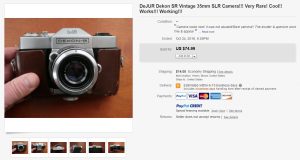
Persistence
Patience and Persistence might seem like the same thing, but what I mean is that not only do you have to wait, you also have to keep trying. If you are really interested in something specific, get used to checking the site regularly. Of course this assumes that the item you are trying to buy is relatively common. If you’re looking for a one off Leica prototype, then obviously this doesn’t apply, but for more common models like Kodak Retinas, Nikon SLRs, or German TLRs, you may need to keep trying.
Research
The more you know about what you are buying, the better able you will be to spot a deal. This is something that comes with time after collecting cameras for a while. Read online reviews and join enthusiast groups such as the Vintage Camera Collectors group on Facebook. Ask questions, and you’ll eventually gain a better understanding of what is a deal and what isn’t. I can say that my ability to snag a deal is greater now than when I first started collecting as I know more of what to look for.
Make Use of Lists
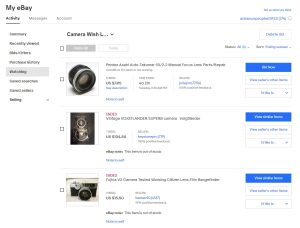
For deal hunters like myself, eBay’s lists are one of my most valuable tools. You are likely already familiar with the Watched Items list which shows items that you are watching, but you can also make custom lists for other reasons. In addition to the main Watched Item list, I also have a list called the Camera Wish List where I put things on as a reminder of previous cameras I’m still looking for. Sometimes I’ll see a rare camera that interests me, but the price is too high. I’ll add the “too high” item to my Camera Wish List so I can remember that if I ever see it again for a cheaper price to go for it. I don’t know if there is a limit to how long things can be on your lists, but I’ve had things on there for a year and eBay never deletes them.
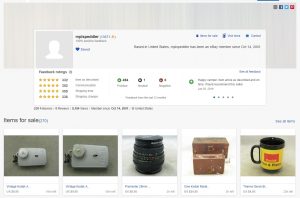
Sellers Other Items / Stores
Looking at an eBay seller’s store or their other items for sale isn’t much of a trick, but it is a way of turning an OK purchase into a great one. Although many eBay sellers famously start out auctions for very high prices, there are still sellers that will list things with a low opening bid and are willing to “let it ride”. Sometimes even, a camera can be listed for far below it’s collector’s value and represents a great deal. If someone is willing to do that to one camera, they might do it for others.
If you see that Nikon SLR or Yashica rangefinder for below market value, even if it’s a model you aren’t interested in, it’s worth a few moments to see if they have any other deals on something you do want. Not only can that help you find more than one item for a great price, but most sellers also combine shipping on multiple items, further increasing the value by splitting up the shipping costs over multiple items.
This is especially useful for international sellers where shipping costs can be quite high. When I bought my Zeiss Pentacon FM from a seller in Lithuania, I was able to better justify the shipping cost by also adding in the Pentacon Penti II and Pouva Start to the same package for nearly the same amount of shipping. And speaking of international sellers…
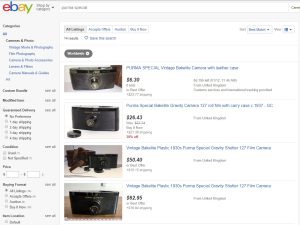
Buy Internationally
When using the US eBay site, some international items will show up in your regular searches, but not all of them. You can easily tell an international item in a search list because the price will be in italics to indicate that the price is based on that day’s currency conversion ratio. I’ve read some suggestions where people will manually search international sites like http://ebay.de or http://ebay.co.uk but you can get the same information by manually selecting the “Worldwide” option in the search settings window.
I did a quick search on the US site for “Purma Special” and only got 2 hits. But when I selected “Worldwide”, there were 14 results. Sometimes, sellers wont list that they’ll ship to your country, but sometimes this is in error, or done intentionally to keep casual shoppers away. I’ve had luck with some German sellers who did not list that they’d ship to my country who were still willing to do it after asking them.
Of course, all international shipping comes with increased risks due to longer travel, unreliable foreign postal markets, or unscrupulous sellers. This is where eBay’s feedback system is really helpful. Where I might take a risk on a domestic seller with a feedback of 20 or less, I might want to look for a foreign seller with a higher number than that to be extra careful.
For shoppers outside of the US, customs and other related import duties can dramatically increase the cost of buying internationally. Thankfully, it doesn’t seem like there’s too much difficulty getting things into the United States as I’ve gotten things from Canada, Japan, Russia, Ukraine, Germany, France, and England all without additional fees, but your country might be different so it’s important to understand how this works before shopping.
Use Saved Searches
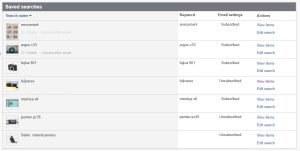

If you find yourself searching for the same types of things over and over, a good time saver is to save your searches. eBay’s site has moved this feature around several times, and it works differently on the mobile app, but each time you search for something, there should be a little heart, usually near the top that says “Save Search”. Clicking this will not only save the search criteria, but also alert you via email each time a new item is listed that meets the terms of your search.
I personally don’t find the email alerts to be too helpful because they can easily overwhelm your inbox. Not only will it find items that aren’t necessarily cameras, but if you add more than a few saved searches, you’ll likely get a lot of false positives. Thankfully, you can unsubscribe from anything in your Saved Searches list and only look at it when you feel like it.

Use Saved Sellers
In addition to saved searches, saving good sellers can be helpful too for future purchases. Many sellers are actual big time camera stores like KEH (kehoutlet) or Robert’s Camera (robertscamera) who regularly have thousands of auctions going at the same time.
If you are apprehensive about buying things on eBay because of a bad experience in the past, sticking to the reputable sellers is a good idea. This is also useful for International sellers who are more willing to work with foreign buyers.
Don’t limit yourself to the big shops though. If you had a pleasant experience with an individual seller, maybe you want to stay in touch with them as well. I have bought multiple things from the same seller a number of times, and if they get to know you as a good buyer, they may even be willing to cut you a deal on something later, or keep an eye out for something you want.
Make an Offer Even When It’s Not an Option
The Make an Offer option is a useful tool that allows a potential buyer to offer a lower (or sometimes higher) price than the current auction price is for an item. This is a setting that the seller has to choose to enable when they list their item, but just because it’s not enabled for a particular item, the option to send them offers still exists if you click the “Contact Seller” button.
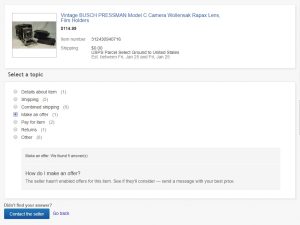
Although it’s not a trick that works often, I have been successful a few times contacting a seller and asking if they’d consider a lower price. For this to work, it is really important that you’re polite, and come up with an offer that is reasonable. If an auction is listed for an item that is higher than other recently sold items, you might want to ask if they’d consider a price that you know others have sold for. You could also try contacting a seller right before an item with no bids is scheduled to end, if ask them if the item ends with no buyers, if they’d consider your lower price the second time around. Some sellers may be inclined to come down after an item has closed at least once without any bids.
I’ve found that making an offer this way has a better chance at working if the item has been listed for a long time without any bids. If an item is listed for 30 days, and there’s only a couple of days left, or if you’ve seen it end and be relisted a couple of times, there’s a chance that the seller might entertain a lower offer. Obviously, it makes no sense to try and haggle on an item that someone has already bid on. When selling an item, sellers have the option to automatically relist something for the same price. If they have this option selected, they may not even be aware of how long it’s sat out there, so if you mention that you’ve been watching it for a couple of weeks and have been on the fence, but would consider it at a lower price, maybe they’ll take you up on it. I’ve also had limited luck in getting a seller to accept an offer if I’ve previously bought something from them or are buying multiple items at once.
As I already said above, the key here is to be nice. Don’t argue with them. Make sure you have a good grasp at writing well thought out, but short, messages. Using poor grammar, slang, or tons of emoji in your request makes you come off as ignorant, and a good seller is less likely to want to deal with an ignorant buyer. But if you ask nicely and come off as an intelligent buyer, this may work in your favor. And if it doesn’t, don’t argue with them. Just thank them for considering your offer and move on.
Search for Local Sellers
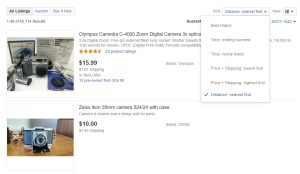
When browsing eBay, one of the sort options is “Nearest First”. If you live in a highly populated area like I do, sometimes you can find stuff being sold by a local seller who might consider allowing you to pick it up in person, saving the shipping cost. You should always ask the seller if they offer local pickup though, don’t just assume that because they’re close to you, they’re willing to meet up somewhere. It’s also worth noting that if the local seller is also a business, they may be required to charge you sales tax for your state, even if you pick it up locally.
While there likely won’t be a large number of highly desirable cameras within a short driving distance, you never know if you don’t look. If you are successful at meeting up with a local seller, see what else they have for sale, or ask them if they frequently sell camera stuff, maybe you’ll find a local source of future purchases before it even makes it to eBay.
Buy on Holidays and Off-Peak Times
I don’t have any statistics to prove this, I would guess that greater than 90% of sold auctions on eBay receive bids within the last few minutes or seconds. eBay is busiest in the evenings on weekdays and weekends, so that means that auctions that close during those times will have the most competition. You can get a slight edge on a cheaper price by searching for items that close during off-peak times like the middle of the night, or on holidays.
That doesn’t mean you should ditch your family on Christmas day to trawl for bargains, but if you have an opportunity to check the site when more people are distracted with other things, there is a slightly better chance you could get a deal.
Use Third Party Tools
Of all the tips mentioned here, the one that has the highest chances of success are to use third party tools, such as “Auto-snipers” to help you buy things at the very last second. Most of these tools are available via the web, or through a smartphone app so you can access them on the go. I won’t go into much detail about what sniping is or how it works, as a simple Google search will reveal many results.

The hardest part about using third party tools, is that there are so many of them to choose from. Surprisingly, I don’t ever use snipers as I prefer to monitor auctions manually. In my research for this article, I found no less than 10 snipers to choose from:
Looking through each of these, some are free and some are not. Since the free ones seem to perform the same task as the paid ones, I can’t honestly see any reason why anyone would want to pay to use a sniper. Regardless of which one you choose, you must be careful as in order for a sniper to work, you must give them full access to your eBay account, including your password. Although it is generally good practice to never reuse the same password on multiple online sites, many people still do it, and if you do, make sure your eBay password is truly unique and not shared with other sites as you don’t want to risk these services having the same password you use for other accounts.
Other Third Party Tools
There are third party tools that can do things beyond sniping such as Last Minute Auctions, which automatically returns auctions ending in less than an hour that are 1 pound (it’s a UK site) or less.

Another site called Baycrazy has a variety of tools that help you spot auctions with 0 bids, or ones with misspellings, or ones ending at night as well.
Fatfingers is another that specializes in items with typos in the listings.
I can’t really say how helpful each of these sites are as I don’t use them, but also most of what they do can be accomplished using the various filters in eBay’s built in Search, but I suppose for some people, having a dedicated site can be useful.
Don’t Snipe
This might sound counterproductive, and I’ll be honest in that I can’t actually prove this theory with any type of statistical evidence, but I firmly believe that sometimes sniping, whether manually or using an auto-sniper, doesn’t always help you get the best price. The most obvious reason is that sniping actually only guarantees you a win if you’re the only person sniping. If two people try to snipe the same item, whoever’s sniper was fastest or had the highest price will win. You could try to snipe 10 different cameras and win none of them, so in reality, the more people who use snipers, the less effective they are.
My theory about why sniping might not always be your best bet, is that the cheaper an item is for longer, the more attention it will get. I feel that by bidding up an item earlier in the auction, future potential bidders might not be as interested and could be more likely to make no attempt to buy it.
Here’s an example, lets say there were two auctions for two identical cameras that have a going rate of about $500, both are in the same condition, and both have auctions that start at $10. Let’s say my target price for that camera is $400.
If I wanted to snipe the camera, I would put the camera on my watch list and either setup an auto-sniper, or just set a reminder to be available right when the auction closes. The thing is, if this is a desirable camera, there’s likely going to be many other people thinking the same thing. They see that $10 opening bid price and think, I’d like to get that $500 camera for cheap, so they do the same thing as me and prepare to snipe it. Seconds before the auction closes, I throw out my $400 bid, and I lose because someone sniped me at $405.
For the second camera, I’m the first bidder and throw out a $400 bid right at the beginning of the auction. The price of the camera will remain $10 until at least one other person starts bidding. Over the course of the auction, lets say a few other people come along and start to bid up the price to $350 before they get discouraged and stop. The camera remains at $350 throughout the majority of the auction and because $350 is less of a deal than $10, it attracts less attention and no one comes along and snipes me and I win it at $350.
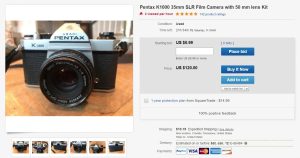
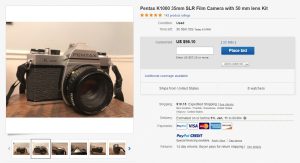 I tried to look for a real-world example of this situation and found these two Pentax K1000s. Both are in decent condition, have a similar Takumar 50mm f/2 lens, and both were described as being in working condition. As I write this, I took screenshots of both auctions while they were still ongoing. One camera has no bids and is 99 cents with a $120 BiN (which I think is too high), and the other has been bid up several times to $56.10. I waited until after both auctions closed and took another screenshot to show what they sold for.
I tried to look for a real-world example of this situation and found these two Pentax K1000s. Both are in decent condition, have a similar Takumar 50mm f/2 lens, and both were described as being in working condition. As I write this, I took screenshots of both auctions while they were still ongoing. One camera has no bids and is 99 cents with a $120 BiN (which I think is too high), and the other has been bid up several times to $56.10. I waited until after both auctions closed and took another screenshot to show what they sold for.
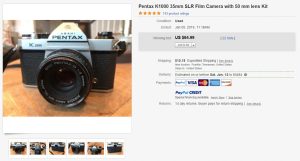
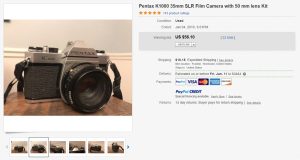 The first example that had no bids with 21 hours to go, closed at $64.99. The second example that was sitting at $56.10, sold for that same price suggesting that more people were drawn to the 99 cent camera than the one that already had bids prior to it closing. Now of course, no two used cameras are truly identical. The first camera had a SMC Pentax-M 50/2 lens and the second one had the later SMC Pentax-A 50/2 lens. The second one had a tiny ding on the top of the pentaprism. The first camera only came with a strap, and the second had the original Pentax lens cap and a strap. Could any of these variances affected the final price? Of course, and with less than a $10 difference in final prices, it hardly makes one more of a deal than the other, but at the very least, at least adds a little bit of plausibility that in some instances, my theory may work in your favor.
The first example that had no bids with 21 hours to go, closed at $64.99. The second example that was sitting at $56.10, sold for that same price suggesting that more people were drawn to the 99 cent camera than the one that already had bids prior to it closing. Now of course, no two used cameras are truly identical. The first camera had a SMC Pentax-M 50/2 lens and the second one had the later SMC Pentax-A 50/2 lens. The second one had a tiny ding on the top of the pentaprism. The first camera only came with a strap, and the second had the original Pentax lens cap and a strap. Could any of these variances affected the final price? Of course, and with less than a $10 difference in final prices, it hardly makes one more of a deal than the other, but at the very least, at least adds a little bit of plausibility that in some instances, my theory may work in your favor.
Now of course, this theory makes many assumptions. If even one person still sets up a snipe for the second camera, I’ll still lose, and that’s what’s hard to prove. Without a time machine, there is no way to know what would have happened after an auction is over if I had used a different tactic. But statistically, I have to believe that my odds are better at winning a camera for less money if there’s less people interested in it, and a camera that attracts less attention should me that my odds are better.
Advanced Searches
eBay is a big place with a lot of stuff for sale. As I write this, there are 65,714 items listed in Vintage Cameras and another 75,987 in Film Cameras. With over 140k listings at any given time, you’ll likely never get through them all. Sometimes you have to specifically search for what you want.
eBay’s search bar is quite powerful and allows for more complex Boolean searches using AND, OR, and NOT logic. This is useful when you want to find multiple models of the same thing, or even common misspellings of the same thing. Here are the basics.
The simplest type of search is an AND search. Any time you type more than one word into eBay’s search, you are performing an AND search. You don’t actually need to type the word AND in between your words, eBay will automatically assume you mean to search for auctions where every word appears in the auction listing.
Let’s say you want to search for a mint Nikon F3. You would simply type:
eBay will return any item with the words “mint” AND “Nikon” AND “F3” anywhere in the title. These three words can be in any order, so an auction named “Nikon F3 with 50mm Lens and Bag in Mint Condition” would show up, as would one that simply says “Mint Nikon F3”.
Let’s say you are looking for an advanced Nikon film SLR, but don’t have a specific model in mind and you want to consider the Nikon F4, F5, or the F6. You could individually search for each of those three, or simply type:
 When you separate search terms with a comma and put them within parenthesis, eBay reads it as “Nikon AND F4” OR “Nikon AND F5″ OR Nikon AND F6”, which effectively combines three searches into one.
When you separate search terms with a comma and put them within parenthesis, eBay reads it as “Nikon AND F4” OR “Nikon AND F5″ OR Nikon AND F6”, which effectively combines three searches into one.
Sometimes searching for what you want includes too many results and you want to be more specific. This where is where excluding results can come in handy.
Let’s say you want to search for a Yashica Electro GS. The problem is, that there is also a model called the Yashica Electro GSN that keeps showing up in your results, so you want to search for Yashica Electro GS, but exclude any that also have GSN in the title.
The minus sign before a search term means “not” or “exclude” that term. The above search is interpreted as “Yashica” AND “Electro” AND “GS”, but not “GSN”. It you want to exclude multiple words, you simply put the words you want excluded in parenthesis, separated by commas.
Another handy trick is to search for an exact phrase. This is useful in situations where the words you are searching for are really common and appear in many auctions that you don’t want, or if you are looking for an exact spelling (or misspelling) of something.
You perform an exact phrase search by including your search terms in quotation marks. This tells eBay to search for auctions with those exact words in that exact order only. If you wanted to search for Nikon 35mm lenses, and you typed:
You would get 12,834 results of any auction with the words Nikon and 35mm anywhere in the listing, including cameras, accessories, and any number of other items.
But if you include that same search to be within quotes:
You narrow that list down to 358 items where the listing says Nikon 35mm right next to each other.
Earlier in this article, I suggested purposely searching for misspelled items, as this could mean the seller is not familiar with the item they are selling and may have it for too low of a price. The problem with intentionally searching for misspellings is that eBay has an auto correct feature which tries to correct misspelled search terms, negating your ability to purposely search for them. You can bypass this auto correct by searching for a misspelled word like “Voightlander” in quotation marks:
The examples above are all simple searches that only scratch the surface of what Boolean logic can do. There are even tricks such as wildcards which I don’t even mention because they’re probably not very useful for a beginner. If you’d like to learn more about mastering eBay’s search and how to apply Boolean logic to more terms, there are plenty of guides and posts a Google search away, such as this one.
Conclusion
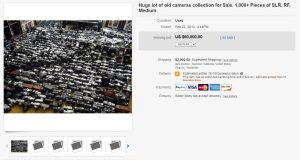
That sums up all of the tips and tricks I’ve come up with and used over the years to help build my collection. Is eBay perfect or the only source for vintage cameras and photographic equipment? Of course not. Are there unscrupulous people trying to pawn off junk for sky high prices? Absolutely, but if you do your homework and know what you’re looking for, there’s no reason that the overwhelming majority of your purchases can’t be good ones.
It’s important to remember that even with every tip mentioned here, you’re never guaranteed to get a deal. Auctions will slip through the cracks, you’ll miss out on an item because you forgot to bid (I’ve done this an embarrassingly high number of times), or simply just didn’t bite when you should. The important thing to remember is to be patient. With the exception of truly rare cameras, most models will show up for sale again. It might not be tomorrow, or next week, or even next month, but it will. Just be Patient, be Persistent, and do your Research!
Did I miss anything? Do you have any tips that have worked for you? If so, let me know in the comments!









Much good advice here, Mike – especially your explanations of how to configure a model-specific search. That information is hard to come by.
.
Eighteen years on eBay, and as a “top rated seller” with 100% positive 7600 feedback score, gives me some background to draw on. I buy almost as much as I sell because I’m a camera / lens restorer. I’ve used eSnipe for over a decade and recommend it highly. The cost is a penny per dollar of winning bid. Their “bid bot” has never failed to place my bid, not once in close to one thousand auctions. There are occasions when I don’t win an auction, but that’s simply because someone else was willing to pay more than I was. GAS is financially constrained by the discipline of setting a snipe bid dollar figure, and refusing to engage in last-minute bidding.
.
Readers of this blog should also know to check both “completed” AND “sold” listings for items in which they are interested. These reveal not only the going price range for the item, but also how many were listed and remained unsold. Akin to the tools used in real estate, these two “views” of parity items indicate current market value very well.
.
Considering the feedback count and score of the seller is also important – as is the quality and number of photos the seller puts in the listing. Unless you’re a gambler, you might wand to avoid outright all auctions posted by sellers with very low feedback, or high negative feedback … and listings with photos that show cameras half-hidden in cases, and with lens caps mounted … or with the words “estate sale find” or “I don’t know much about cameras”. Auctions like this are often great sources for lenses with haze and fungus, shutters that don’t work properly, and the like. But, on occasion, they can be treasure chests. It all depends on your tolerance for financial risk.
.
There are a couple of other powerful tricks one can use to find mis-priced photo gear but, I ain’t revealing those … (:>)
One more comment: Your advice to be patient is spot-on. I used to be a member of the Exakta Circle and an avid Exakta collector (talk about a bad case of GAS …) Twelve years ago the majority of Exaktas on eBay were crap: Corroded and pitted chrome finish, peeling leatherette, and invariably nonfunctional or pinholed shutters. Nowadays, real beauties show up weekly on eBay. I have noted the same thing with other marques as well. I suspect that both the strong, post-Obama economy (which has pushed up prices of everything) is making selling more attractive than keeping, for folks who are not dead-serious about analog photography.
.
I also know for certain (based on my own estate sale shopping) that the majority of under-30s think photography is something one does with a smart phone. That bag full of Canon or Nikon gear they inherited from papaw is of no interest to them.
.
Net result is that both better gear, and more of it, is now in the market place … which is a good remedy for sufferers of GAS attacks!
Great post, Mike. I had forgotten a few of the tricks you’ve mentioned even though I’m quite successful with most of my bidding it’s always good to take another look at how you approach eBay. I will say that in all of my years of bidding that I’ve never bid early or often on an item that I really want to acquire. I wait until the final seconds and go from there. Bidding early and high on an item locks you into it. If another better deal (or better camera) comes along while you’re waiting for that auction to end you’ve put yourself in the position of being committed to it and unless you retract your bids (bad karma) you wouldn’t be able to go for the better deal whether it’s an auction or a buy it now.
I started with eBay back in 1999. I bought most of my cameras between 1999-2004. That would be about 130 of them. I know it sounds bad. However, back then most everything was an auction and BIN was very rare. My success rate in auctions would be around 85% and all cameras were bought for under $50. Only two cameras were over that amount. One, a Minolta Autocord with meter that I won in an auction for $85. The second, a Nikon F2 working body for $95 on a BIN. Stiffed only once and received only five cameras that truly didn’t work nor were repairable and misrepresented of course. All auctions won were won in the last 10 seconds.
Between 2004-present I have only added 50 more and pretty much am done as there is only one left that catches my eye. Yes, prices have gone through the roof and some of my cameras are now valued at 4-5X what I paid. However, many are highly overpriced and most are BIN rather than auction. So I rarely partake anymore but I do follow. One conclusion I have come to is that if the BIN price is really good the camera sells in under an hour. If the price is good the camera sells in under 24 hours. After 24 hours they rarely sell which means they are priced to high and will never sell. Same holds for cars that I watch.
I don’t necessarily think cameras are overpriced now, I think their prices are being “corrected” from the insanely rock bottom prices they went for in the first 10-15 years of the 2000s. Consider a Retina IIa sold for $168.50 in 1952, which when adjusted for inflation is over $1500 today. Even a relatively “mundane” camera like the Canon AE-1 originally sold for about $239 in 1976 which when adjusted for inflation is over $1000 today. Despite the deals not being as amazing as they were 5-10 years ago, I think it’s a stretch to say they’re overpriced today.
I wholeheartedly agree with you that good manners go a very long way, especially when contacting a seller directly. Even if your request is rejected out of hand, do thank them for their timely reply.